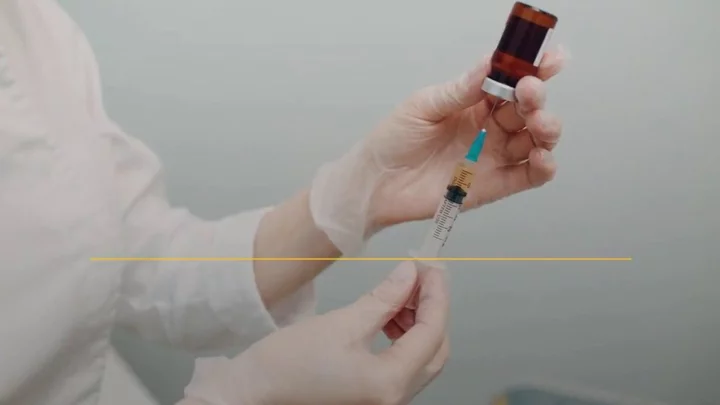
Bumble CEO Predicts AI Dating Coach Will Teach You How to Flirt
There are many predictions about our AI future that veer into Black Mirror territory, but perhaps the most
2023-08-31 23:18

Broadcom’s Earnings Will Test Whether AI Euphoria Is Fading
Having unlocked stock market riches in 2023, the “artificial intelligence” catchphrase faces a shift in sentiment — and
2023-08-31 22:21

'Altcoins' central to Hong Kong crypto firm HashKey’s first liquid fund
(Corrects company name HashKey with capitalisation of letter K) By Summer Zhen HONG KONG (Reuters) -The first secondary crypto market
2023-08-31 21:29

Scientists may have just found a cure for alcoholism
Alcohol addiction ruins millions of lives every year, but scientists may have found a cure for this terrible affliction. A new treatment for alcohol use disorder (AUD) has been trialled in monkeys with impressive results and, if these translate to human trials, the impact could be monumental. A team of neuroscientists and physiologists from across the US tested a new type of gene therapy to see if they could directly target the underlying brain circuitry associated with sustained heavy drinking. As they noted, in the journal Nature Medicine, people suffering from AUD commonly return to alcohol use even if they attempt to quit. This is largely to do with what’s known as mesolimbic dopamine (DA) signalling – meaning how the central nervous system circuit communicates the feelgood neurotransmitter dopamine. A protein called glial-derived neurotrophic factor (GDNF) is key to keeping these neurons in this reward circuitry functioning. However, experts have found that levels of GDNF are reduced in people with AUD during periods of alcohol abstinence, most notably in a region of the brain called the ventral tegmental area (VTA), as IFLScience notes. Therefore, the researchers decided to test whether using gene therapy to deliver more GDNF to the VTA could help reinforce this crucial dopaminergic signalling and prevent patients from suffering an alcoholic relapse. The team of scientists explained how alcohol consumption in non-addicts prompts the release of dopamine, creating a pleasurable buzz feeling, but chronic alcohol use causes the brain to adapt and stop releasing so much dopamine. “So when people are addicted to alcohol, they don’t really feel more pleasure in drinking,” Dr Kathleen Grant, a senior co-author of the study, said in a statement. “It seems that they’re drinking more because they feel a need to maintain an intoxicated state.” For their research, Dr Grant and her colleagues used eight rhesus macaque monkeys, who were exposed to increasing concentrations of alcohol over four 30-day “induction” periods. The monkeys then had free access to alcohol and water for 21 hours a day for six months, during which they developed heavy drinking behaviours. This was then followed by a 12-week abstinence phase, with the GDNF treatment performed four weeks in for half of the subjects. The gene therapy was delivered using a a viral vector containing a copy of the human GDNF gene injected directly into the primate’s VTA, according to IFLScience. And the results were truly jaw-dropping. “Drinking went down to almost zero,” Dr Grant said. “For months on end, these animals would choose to drink water and just avoid drinking alcohol altogether. They decreased their drinking to the point that it was so low we didn’t record a blood-alcohol level.” The most exciting aspect of their findings is the suggestion that gene therapy could offer a permanent solution for people with the most severe cases of AUD. This will be a welcome glimmer of hope to many, given that some 29.5 million people were diagnosed with AUD in the US alone in 2021, according to the National Institute on Alcohol Abuse and Alcoholism. Of these 29.5 million sufferers, almost a million (894,000) were aged between 12 and 17. It’ll likely be some time before we know for sure whether the gene therapy can be rolled out in humans, but it’s an important first step in tackling this devastating disorder. Sign up for our free Indy100 weekly newsletter Have your say in our news democracy. Click the upvote icon at the top of the page to help raise this article through the indy100 rankings.
2023-08-31 19:46

Elon Musk's X to roll out audio, video calling feature
Social media platform X, formerly Twitter, plans to launch video and audio calls as owner Elon Musk races
2023-08-31 19:23

Fake plastic surgeon arrested after fatal botched penis enlargement surgery
A caterer who pretended to be a plastic surgeon has been arrested after performing a fatal penis enlargement on a 'patient'. Torben K, a 46-year-old man from Solingen, Germany, administered silicone injections into the victim's penis and scrotum area. He reportedly refused to disclose the type of silicone oil. The 32-year-old patient died from sepsis seven months after the procedure in July 2019. An investigation found that Torben had no medical qualifications and previously carried out the same procedure on another man earlier in the year. Judges in Wuppertal District Court found Torben guilty of causing death by grievous bodily harm. The sister of the unnamed victim said her brother had doubts about the treatment but Torben convinced him to go ahead. He was said to experience breathing difficulties as soon as he returned home. The man reportedly visited several hospitals but later died of blood poisoning and liver and kidney failure. Speaking to local media, High State Prosecutor Wolf-Tilman Baumert said: "Unfortunately, the silicone oil ended up in the person's bloodstream. This led to severe health complications and, eventually, to his death." Torben claimed he had only done what the patient requested, to which Baumert responded: "The fact that the man asked for the treatment is irrelevant from our point of view. The defendant acted in a highly immoral manner." Torben was jailed for five years, though the verdict is not yet legally binding. Sign up for our free Indy100 weekly newsletter Have your say in our news democracy. Click the upvote icon at the top of the page to help raise this article through the indy100 rankings.
2023-08-31 19:17

Microsoft will split Teams from Office in Europe after EU pressure
Microsoft will allow business customers in Europe to buy its video and chat app Teams separately from its Office software, it said Thursday, a month after the European Union opened an antitrust investigation into the company's bundling of the products.
2023-08-31 18:28

Student loan interest resumes Friday and payments restart in October. Here's what borrowers should know
For the first time in more than three years, federal student loan borrowers will be required to pay their monthly student loan bills starting in October. The pandemic-related pause, which went into effect in March 2020, provided relief to nearly 44 million borrowers by freezing their accounts.
2023-08-31 18:24

Sea Brings Back One of Its Top Game Titles in India After Ban
Sea Ltd. is bringing back one of its top mobile games in India a year and a half
2023-08-31 17:45

Musk Says X Will Offer Video and Audio Calls in Move Toward Super-App
Users of X, the social network formerly known as Twitter, will be able to make video and audio
2023-08-31 17:25

Northern Europe’s Cool Spell Shifts to Warmer Weather by Weekend
The cool, wet weather that’s predominating across northern Europe as August draws to a close will give way
2023-08-31 17:21

A dead vampire star is firing out 'cosmic cannonballs'
A dead “vampire” star is feeding on a nearby companion and expelling cannonballs and its behaviour has left astronomers stunned. The dead star is located around 4,500 light-years away and, until now, has baffled astronomers with its unusual behaviour. It is a rapidly spinning neutron star, otherwise known as a pulsar, that has been given the name PSR J1023+0038, shortened to J1023. It emits radiation from both its poles that occasionally reach Earth and also appears to have two different “settings” of brightness. Initially, the behaviour of J1023 confused experts, but now they believe that the stark difference in brightness levels has to do with the star launching out matter over short spaces of time. Maria Cristina Baglio, leader of the research team and scientist at New York University, Abu Dhabi, said in a statement: “We have witnessed extraordinary cosmic events where enormous amounts of matter, similar to cosmic cannonballs, are launched into space within a very brief time span of tens of seconds from a small, dense celestial object rotating at incredibly high speeds.” In addition to the pulsar emitting matter, over the last 10 years, scientists have witnessed the star pulling material from its companion star. The material it is stealing forms a structure called an accretion disk that forms around the star itself. Since it began feeding, the star has been alternating between between “low” and “high” power modes. During moments of high power, the star shines brightly with a variation of X-rays, ultraviolet and visible light. During low power, it emits radio waves and appears much dimmer. In June 2021, experts witnessed a star shooting out hot, luminous matter that has been compared to a cosmic cannonball as the star continually switched modes. J1023 has fascinated experts, who have been able to explain the way the star behaves by observing it. Despite solving many of its mysteries, the scientists aren’t done with it yet. With the Extremely Large Telescope (ELT) in northern Chile currently under construction, it is hoped that when it is ready, scientists will once more be able to observe the pulsar. Sergio Campana, research co-author and Research Director at the Italian National Institute for Astrophysics Brera Observatory, said: “The ELT will allow us to gain key insights into how the abundance, distribution, dynamics and energetics of the inflowing matter around the pulsar are affected by the mode switching behavior.” Sign up to our free Indy100 weekly newsletter Have your say in our news democracy. Click the upvote icon at the top of the page to help raise this article through the indy100 rankings.
2023-08-31 17:19
